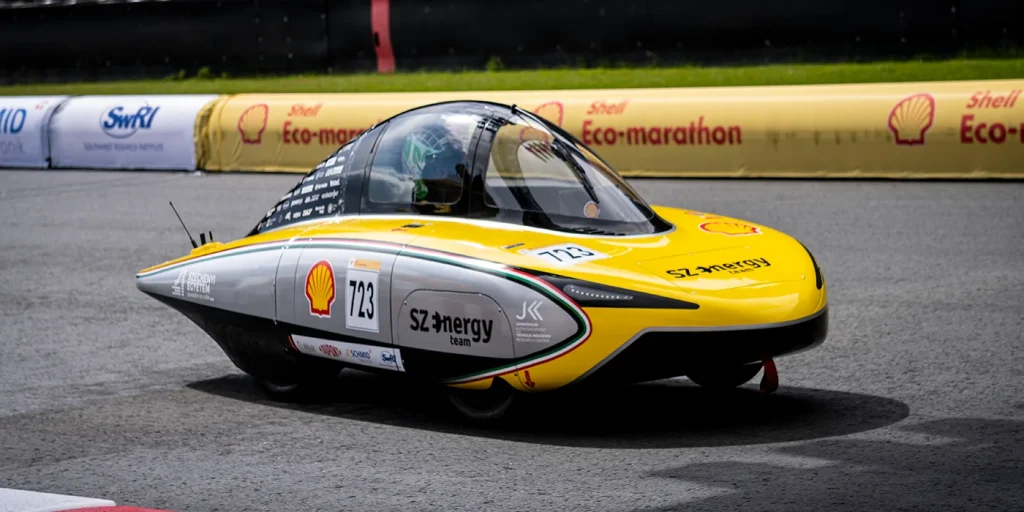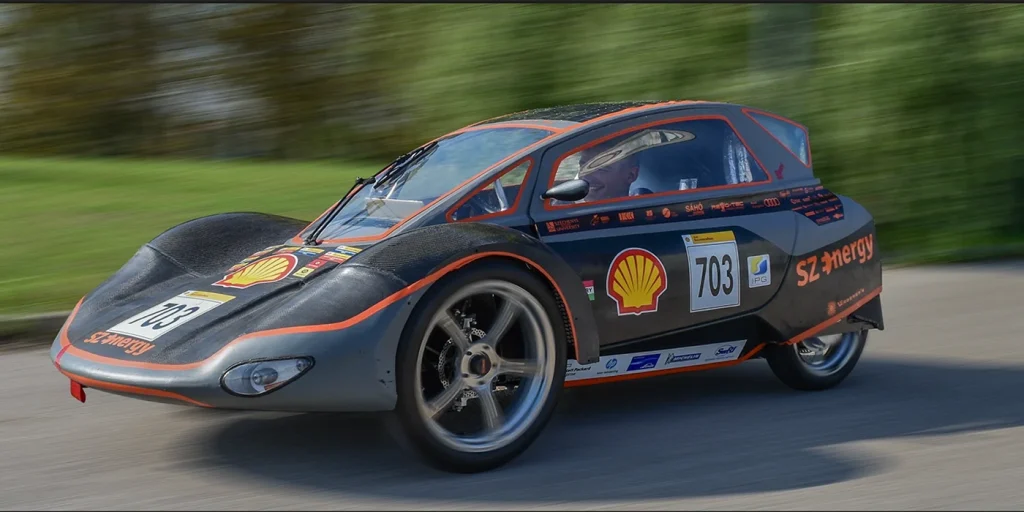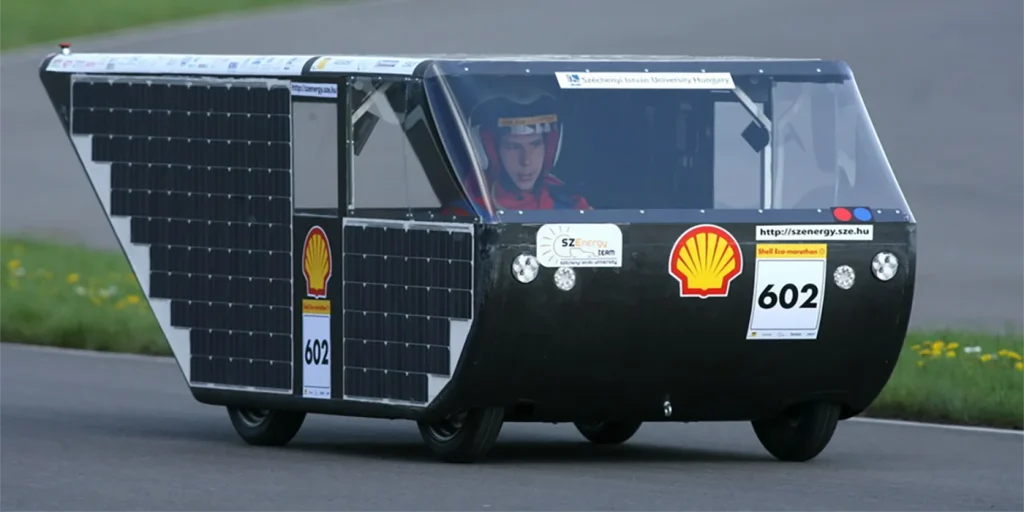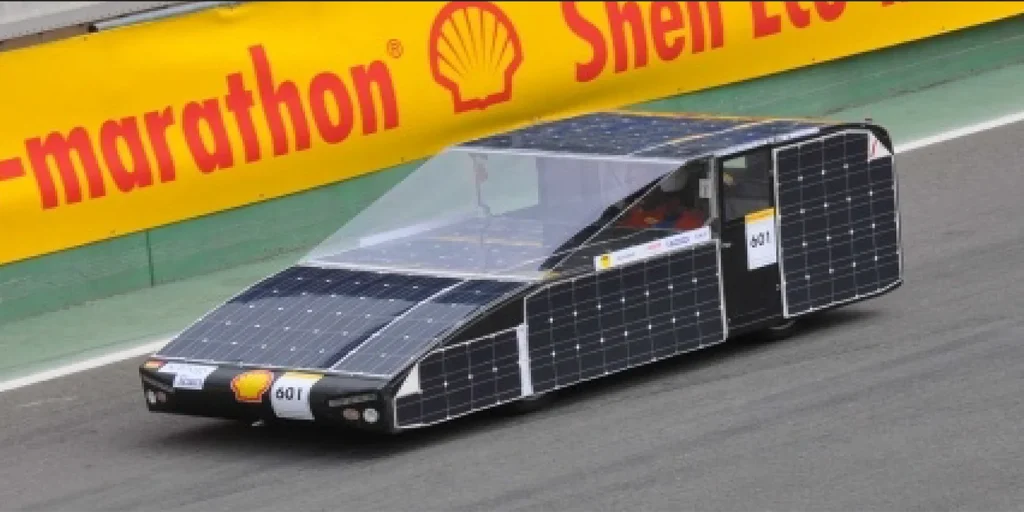Our Racing Cars
SZEmission

Weight: 95 kg
Efficiency: 309 km/kWh
Results on Shell Eco-marathon:
2024 – Nogaro – 1st place
2024 – Nogaro (autonomous) – 1st place
2023 – Nogaro – 1st place
2023 – Nogaro (önvezetés) – 1st place
2022 – Assen – 1st place
2022 – Nogaro (autonomous) – 2nd place
2019 – London – 6th place
Our newest racing car, the SZEmission, was built in 2019, and we have been developing it continuously since then. In the 2022 season, we achieved a world record for energy efficiency with SZEmission at the Shell Eco-marathon held in Assen. Our racing car was able to run 284 km on 1 kWh of energy. In the 2023 competition, we further improved this record, achieving an efficiency of 291 km/kWh. Thanks to the modified drop shape, it has a drag coefficient of 0.1365, which is significantly lower than the 0.3 value of an average passenger car. In addition to air resistance, we also placed great emphasis on weight reduction. The vehicle has a self-supporting carbon-composite body, so its current ready-to-go weight is 95 kg. In SZEmission, we use LiPo 350 – 530 Wh batteries, and it is powered by a PMS motor with a toothed belt drive.
SZElectricity
Weight: 90 kg
Efficiency: 195 km/kWh
Results on Shell Eco-Marathon:
2018 – London – 6th place
2017 – London – 4th place
2016 – London – 3rd place
2015 – Rotterdam – 3rd place
2014 – Rotterdam – 4th place
2013 – Rotterdam – 7th place

As the predecessor of SZEmission, SZElectricity served as the team’s racing car at the Shell Eco-marathon between 2013-2018. At first, the weight of the vehicle was 90 kg. The frame of the car was made of aluminum, then a carbon body was added. Even in this period, the drive was carried out by a PMS motor (250W). SZElectricity had a 0.65 m2 solar panel on top of its body. In addition to monocrystalline solar cells, 48 V Li-ion batteries provided the car’s energy. For the 2015 race, the vehicle underwent major improvements, thanks to which a new nose cone, lightened front suspension and LIN over DC communication were added to the race car. In 2016, our team dreamed even bigger, as they installed an optimized axle stand, a 3D printed rack and pinion steering system, and a self-developed PMS engine with external rotors in the vehicle. In addition, we developed a new power supply, automatic start and cycle control during the season. The most significant development for the 2017 and 2018 seasons was optimization and mass reduction. By reworking the brake system, the reliability of the vehicle has improved significantly, and the sprung suspension has also been redesigned. Our last development was the design of the clutch drive.
SZEvolution

Weight: 138 kg
Results on Shell Eco-Marathon:
2012 – Rotterdam – 2nd place
2011 – Lausitz – special prize
2010 – Lausitz – 1st place
Between 2010 and 2012, the SZEvolution was our team’s alternative drive vehicle. When it was built, its total weight was 138 kg. Similar to the SZElectricity, the study car was composed of an aluminum frame and carbon body, which was powered by two 1kW BLDC motors. Monocrystalline solar panels with an efficiency of 18.5% were found on 7 square meters of the vehicle’s surface, however, in the case of the SZEvolution, the energy source was supplemented with 1 48V Li-ion battery. Our SZEvolution vehicle is the first Urban Concept car of the Shell Eco-marathon that ended the race with a positive energy balance, which means that it ended the race with more energy than it started with.
SZEnergy Car
Weight: 152 kg
Results on Shell Eco-Marathon:
2009 – Lausitz – 1st place

The SZEnergy Car was built in 2008 and competed with our team until 2010. When it was built, the vehicle was 152 kg and, like the others, it was equipped with an aluminum frame and carbon bodywork. A 2 kW BLDC motor was responsible for the drive, for which energy was provided by 7 square meters of 17.5% efficient monocrystalline solar cells and a 48V Li-ion battery. The SZEnergy Car was our first racing car, which achieved the best energy balance in the field.